
By Avnet Insights
Even though it lagged some of the technologies we have used for many years, it could be said that artificial intelligence (AI) went mainstream in 2022 with the launch of ChatGPT. This fourth Avnet Insights research report explores how far AI has penetrated both the electronic product design process and the functionality of end products.
Around eight out of 10 electronics engineers surveyed had products on the market today that feature AI (42%) or are working on incorporating AI into their product designs (40%). Respondents predicted the adoption of AI across a wide range of product applications, with process automation highlighted as a leading application opportunity for the technology. Regionally, China was seen to be leading with AI- enabled products already in the market (66%).
Perhaps surprisingly, there was not a dominant use of AI in the design process, but the technology does touch most stages of design and development from simulation to cross-technology integration. The use of AI in autonomous design and decision-making was ranked number one by a small margin of respondents, but responses were distributed across every stage of product development, with no one category garnering more than 9% of the responses.
In summary, AI is already pervasive both in the product design process and as a product feature. And many respondents believe we’re only seeing the tip of the iceberg.
Survey Methodology
This Avnet Insights survey was carried out online between Oct. 31 and Nov. 15, 2024, and it generated responses from 1,204 engineers across Asia (including Japan), EMEA, and the Americas. All major industry sectors were represented, with nearly half of respondents employed in Information Computing and Telecommunications (ICT).
Approximately two-thirds of respondents indicated they have primary responsibility for their company’s product design; a quarter reported shared responsibility. In other words, the survey respondents were highly influential. Their job roles include software engineers (41%); electronics, hardware and mechanical engineers (31%); and engineering management (27%).
Respondents were evenly spread between companies with revenues between $1 million and $10 million (15%) up to those with revenues between $501 million and $1 billion (18%). Approximately one-fifth of respondents work in businesses with revenues of more than $1 billion.
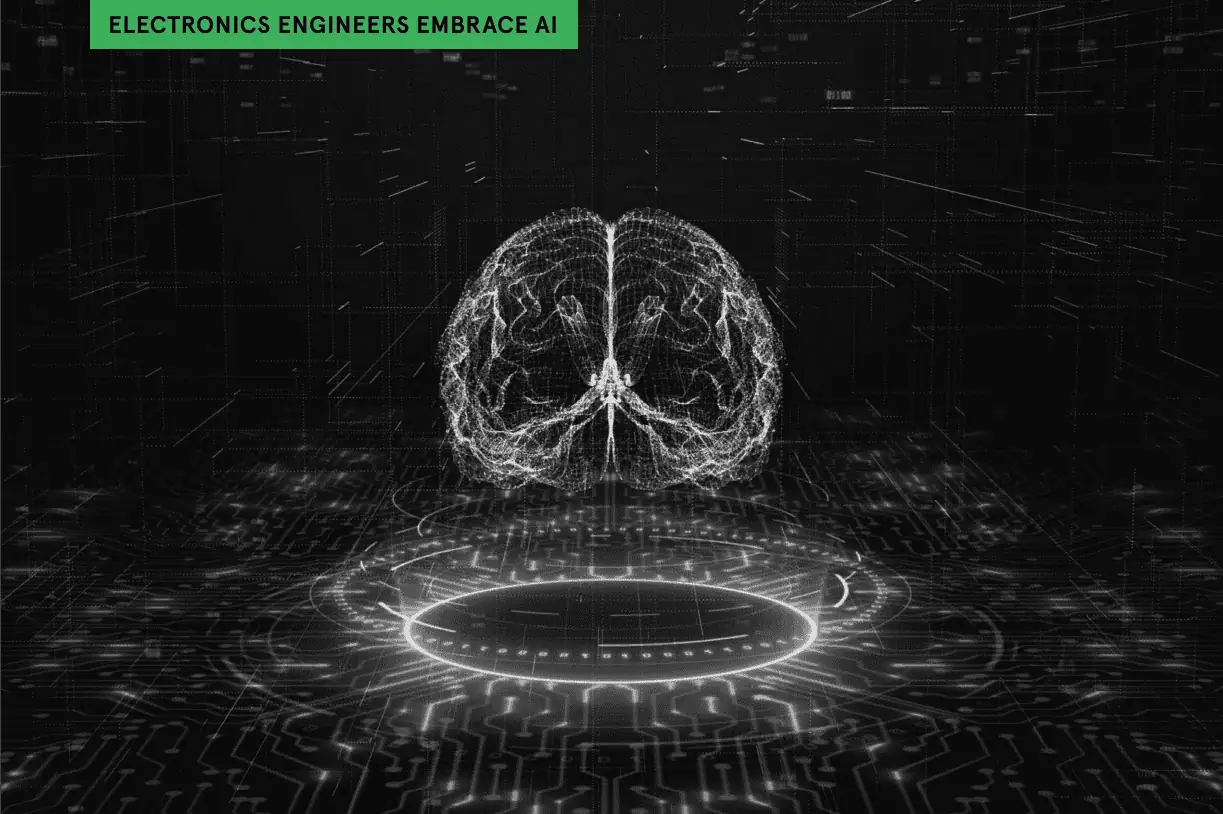
KEY FINDINGS
Main takeaways regarding AI in electronic products:
- Globally, 42% of engineers have incorporated AI into products that are currently shipping and another 40% are working on incorporating AI into products not yet on the market.
- Process automation (42%), predictive maintenance (28%) and fault/anomaly detection (27%), were cited as the AI-enabled functions likely to have the highest adoption rates in the future. Following close behind are biometrics (24%), as well as augmented reality, text-to-speech, and command recognition (all at 24%).
- Key challenges are security and privacy (37%) and data quality (31%).
Main takeaways regarding AI in the product design process
- In terms of AI trends that will have the biggest impact on the design of products, between 5.5% and 9.8% of respondents cited the options presented (ranging from prototyping to testing), but no trend was dominant. This demonstrates the pervasiveness of AI across all aspects of the product design process.
- When asked about the skill most needed to use AI effectively in the design process, over one-sixth of respondents identified AI model optimization, data analysis and interpretation, and problem-solving and critical thinking as the top skills (all at 16%).
AI APPLICATIONS: ACROSS EVERY INDUSTRY SEGMENT AND GROWING
AI is becoming more pervasive than ever, as design teams find more innovative ways to apply its key capabilities, including pattern and anomaly detection, object identification, and natural language processing in applications that range from automotive and medical to precision agriculture.
According to our survey, engineers predict the highest rate of adoption for AI will be in process automation (43%), which comes as no surprise as companies increasingly are evaluating AI tools to improve efficiency, reign in costs and streamline operations and routine tasks. Second is predictive maintenance (28%), followed by fault/anomaly detection (27%)—two applications for AI that are growing in popularity in industrial environments. As companies continue to chase manufacturing efficiency, the ROI of new technologies like AI that automate or streamline tasks can often easily justify the investment. That’s been the case with Internet of Things (IoT) technology, which is becoming almost synonymous with AI today. Note that service industries like finance, which are expected to rely heavily on AI in the future, were excluded from the survey.
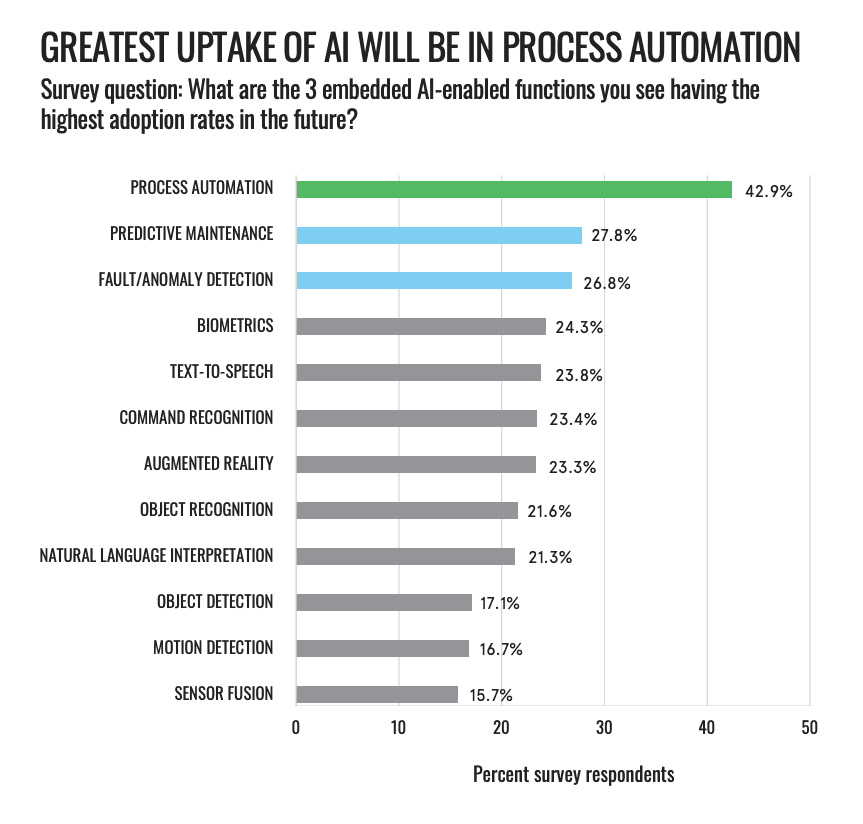

Security and privacy concerns (37%) and data quality (31%) topped the list of challenges of AI cited by survey respondents. While these concerns are not strictly new, the scale at which AI systems require data, and in some cases very sensitive personal data, is making engineers aware that security and data privacy must be prioritized across the product lifecycle. There is also the potential for compromised data to manipulate or trick an AI model and impact its decision-making, necessitating the need to fortify models.
Given the recent reports around the shocking amount of energy the coming AI boom is projected to consume, coupled with the trend toward AI processing to the edge, it may be surprising that survey respondents did not rank power requirements as one of the top challenges when considering integrating AI into product designs. It may be that some engineers are familiar with designing embedded systems under extreme constraints and understand how to make the appropriate trade-offs in power and performance at the device level.
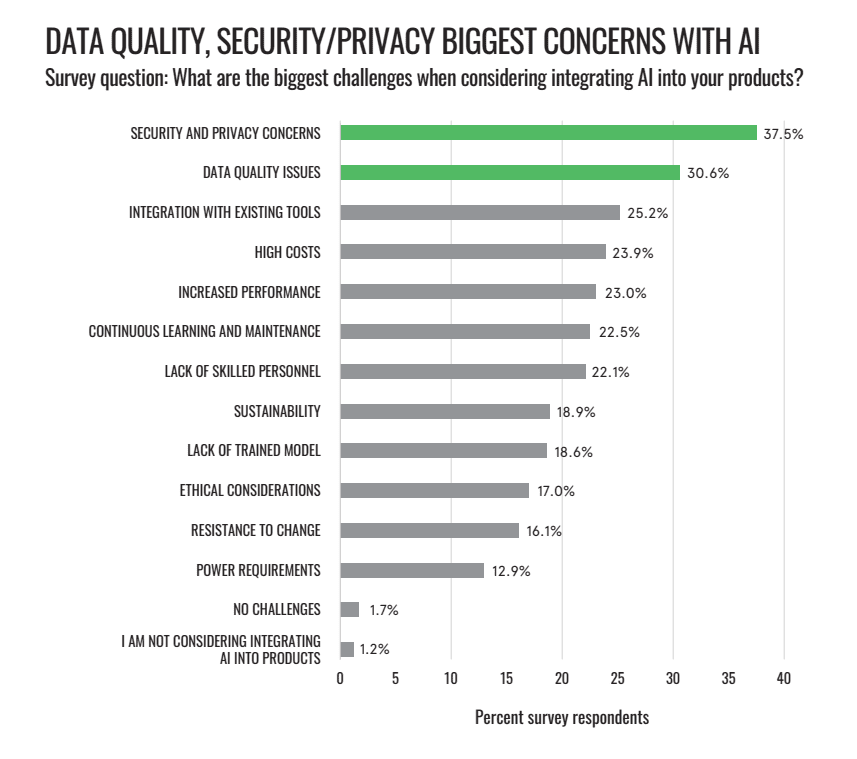
AI: A MAJOR IMPACT ON THE DESIGN PROCESS
For context, respondents were asked about which AI tools they use when they’re seeking information during the design and development process. ChatGPT (64%) is still hanging on to its first-mover advantage and topped the list, but Google Gemini (52%), Microsoft Copilot (47%) and Meta AI (43%) were not far behind. Some 6% reported that they do not use any AI tools to answer technical questions.
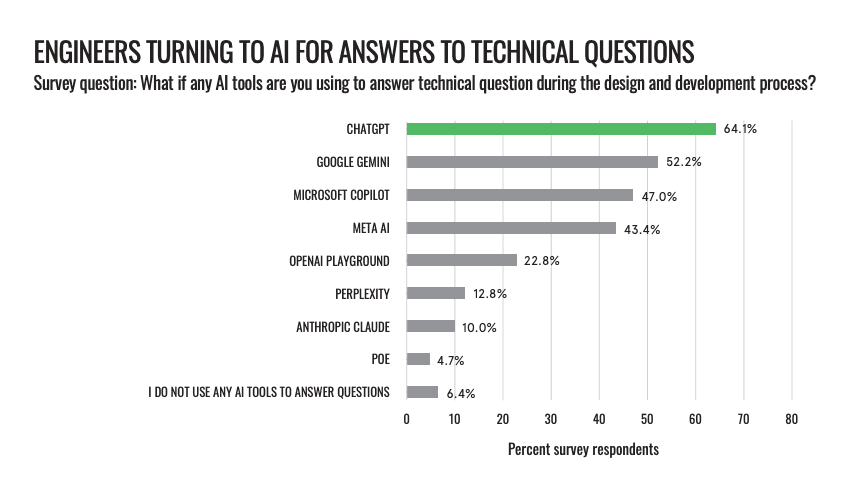
AI is transforming the product design process end-to-end through a robust toolkit designed to streamline workflows, speed
time to market, and assist in a better understanding of market trends and customize designs. As to whether (and to what
extent) and in what areas AI will influence product design in the next three to five years, survey respondents were in near
unanimous agreement that it’s “somewhat” to “extremely likely” that AI will make a positive impact across all aspects of
product design.

AI’s role in supporting specific tasks across the product design process—from code generation to simulation—is expanding as
engineers develop experience with new AI tools. When asked about what AI trend would have the biggest impact on product
design, engineers’ responses were as across-the-board as the tools themselves—from rapid prototyping to AI-driven testing.
Autonomous design and decision-making at 10% ranked first, but responses were distributed across every other category.
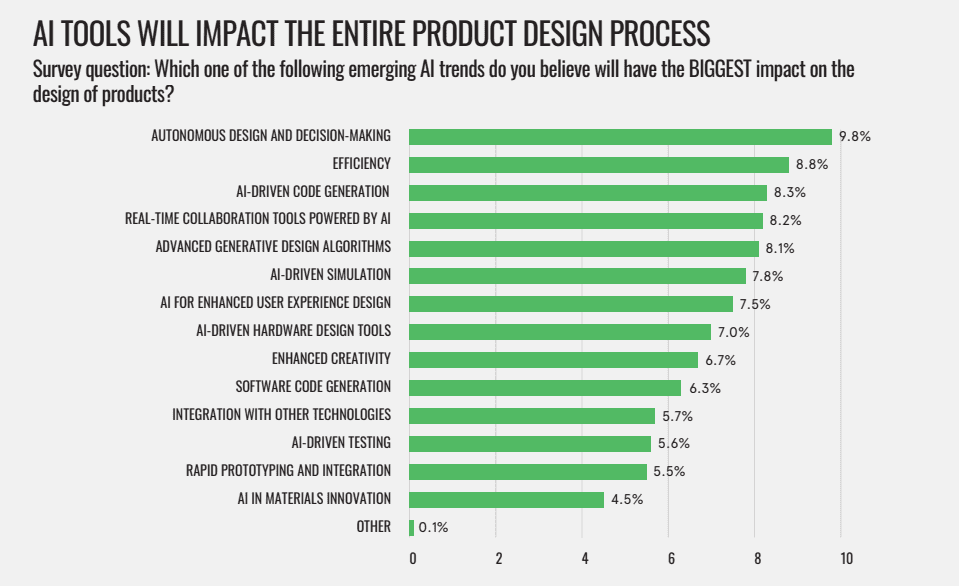
When asked about the additional skills they may need to maximize their effectiveness in using AI tools within the design
process, respondents highlighted AI model optimization (17%), data analysis and interpretation (16%), and problem-solving and
critical thinking (16%) as top skills engineers will need. However, other significant concerns mentioned by more than one in 10
respondents include an understanding of AI/ML algorithms (13%) and proficiency in using digital design tools (12%). Clearly,
training is going to be necessary for effective use.
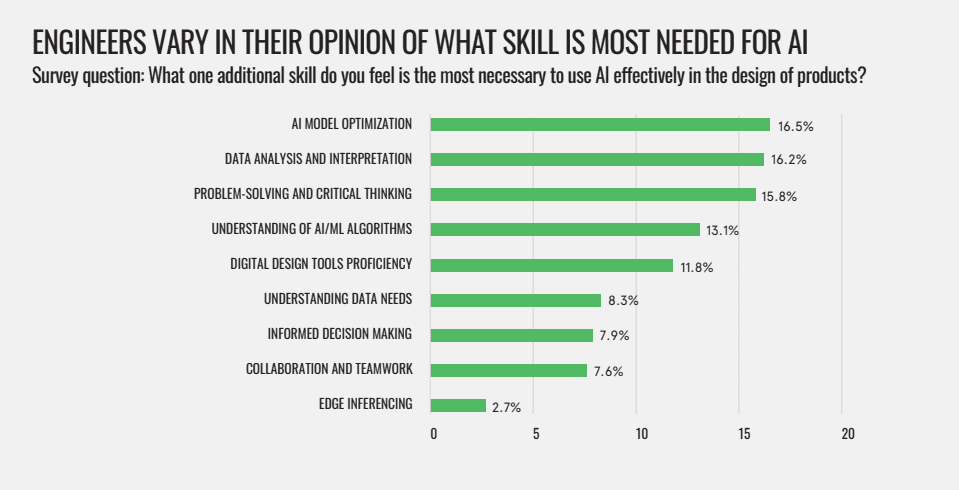
ADDITIONAL OBSERVATIONS: REGIONAL VARIANCES
Responses from the different regions were broadly similar but there are a few interesting variances to note.
In Japan, fewer engineers are concerned about the challenges of integrating AI tools with existing tools (9% vs. 25% globally) and
with sustainability (8% vs 19% globally).
With respect to AI-enabled product applications, biometrics was cited much more frequently in the U.S. (31%) and in China (35%) than in
Japan (11%). The global average was 24%.
Regarding the emerging AI trends likely to have the biggest impact on the design of products, engineers in China made significantly greater
mention of autonomous design and decisionmaking (14%), AI for enhanced user experience design (12%), and enhanced creativity (10%).
The global average figure for each of these were 10%, 8% and 7% respectively.
A final point of note is that when the results of responses of software engineers were compared against those of other engineers, there were no statistically significant differences based on job roles.

Conclusion
AI is now pervasive in the product design process and has a growing influence in the functionality of end products. AI is complex and engineers recognize the need to develop their skills through research and training, staying connected to partners that are experts, and connecting with their peers if they are to fully exploit the opportunities that the technology offers.
Bottom line: 2025 looks to become one of the most transformative years for AI’s role in product development and product enhancement.
Additional Resources: Technical Articles from AVNET
Discover more about AI and other tech trends for 2025: What’s Next Magazine


Copyright permission/reprint service of a full TechSplicit story is available for promotional use on your website, marketing materials and social media promotions. Please send us an email at [email protected] for details.
